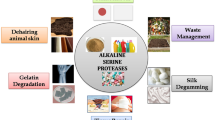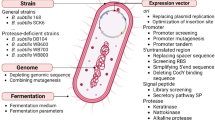Abstract
This study reports the purification and biochemical characterization of an extracellular neutral protease from the fungus Trichoderma harzianum. The protease (Th-Protease) was purified from the culture supernatant to homogeneity by a three-step procedure with 14.2% recovery and 9.06-fold increase in specific activity. The purified enzyme appeared as a single protein band after sodium dodecyl sulfate–polyacrylamide gel electrophoresis (SDS-PAGE) with a molecular mass of about 20 kDa. The optimum pH and temperature for the proteolytic activity were pH 7.0 and 40 °C, respectively. The enzyme was then investigated for its potential application in the production of antibacterial peptides. Interestingly, Scorpaena notata viscera protein hydrolysate prepared using the purified serine protease (Th-Protease) showed remarkable in vitro antibacterial activities. A peptide with a high antibacterial activity was further purified by a three-step procedure, and its sequence was identified as FPIGMGHGSRPA. The result of this study offers a promising alternative to produce natural antibacterial peptides from fish protein hydrolysate.







Similar content being viewed by others
References
Vishwanatha, K. S., Appu Rao, A. G., & Singh, S. A. (2009). Characterisation of acid protease expressed from Aspergillus oryzae MTCC 5341. Food Chemistry, 114, 402–407.
Rao, M. B., Tanksale, A. M., Ghatge, M. S., & Deshpande, V. V. (1998). Molecular and biotechnological aspects of microbial proteases. Microbiology and Molecular Biology Reviews, 62, 597–635.
Zanphorlin, L. M., Cabral, H., Arantes, E., Assis, D., Juliano, L., Juliano, M. A., Da-Silva, R., Gomes, E., & Bonilla-Rodriguez, G. O. (2011). Purification and characterization of a new alkaline serine protease from the thermophilic fungus Myceliophthora sp. Process Biochemistry, 46, 2137–2143.
Archer, D. B., & Peberdy, J. F. (1997). The molecular biology of secreted enzyme production by fungi. Critical Reviews in Biotechnology, 17, 273–306.
Devi, K., Rasheedha-Banu, M. A., Gnanaprabhal, G. R., Pradeep, B. V., & Palaniswamy, M. (2008). Purification, characterization of alkaline protease enzyme from native isolate of Aspergillus niger and its compatibility with commercial detergents. Indian Journal of Science and Technology, 1, 1–6.
Archer, D. B. (2000). Filamentous fungi as microbial cell factories for food use. Current Opinion in Biotechnology, 11, 478–483.
Sathivel, S., Bechtel, P., Babbitt, J., Smiley, S., Crapro, C., & Reppond, K. (2003). Biochemical and functional properties of herring (Clupea harengus) by product hydrolysates. Journal of Food Science, 68, 2196–2200.
FAO (2014). The state of world fisheries and aquaculture 2012: opportunities and challenges (pp. 4–7). Rome: Food and Agricultural Organization of the United Nation.
Kristinsson, H. G. (2007) In F. Shahidi (Ed.), Aquatic food protein hydrolysates: maximising the value of marine by-products (pp. 229–248). Wood head Publishing Ltd..
Kristinsson, H. G., & Rasco, B. A. (2000). Biochemical and functional properties of Atlantic salmon (Salmo salar) muscle hydrolyzed with various alkaline proteases. Journal of Agricultural and Food Chemistry, 48, 657–666.
Thiansilakul, Y., Benjakul, S., & Shahidi, F. (2007). Compositions, functional properties and antioxidative activity of protein hydrolysates prepared from round scad (Decapterus maruadsi). Food Chemistry, 103, 1385–1394.
Song, R., Wei, R. B., Luo, H. Y., & Wang, D. F. (2012). Isolation and characterization of an antibacterial peptide fraction from the pepsin hydrolysate of half-fin anchovy (Setipinna taty). Molecules, 17, 2980–2991.
Bolscher, J. G. M., Van der Kraan, M. I. A., Nazmi, K., Kalay, H., Grün, C. H., Van’t Hof, W., Veerman, E. C. I., & Nieuw Amerongen, A. V. (2006). A one-enzyme strategy to release an antimicrobial peptide from the LFampin-domain of bovine lactoferrin. Peptides, 27, 1–9.
Abidi, F., Aissaoui, N., Gaudin, J. C., Chobert, J. M., Haertlé, T., & Marzouki, M. N. (2013). MS analysis and molecular characterization of Botrytis cinerea protease Prot-2. Use in bioactive peptides production. Applied Biochemistry and Biotechnology, 170, 231–247.
Bradford, M. M. (1976). A rapid and sensitive method for the quantitation of microgram quantitites of protein utilizing the principle of protein-dye binding. Analytical Biochemistry, 72, 248–254.
Phillips, P. K., Prior, D., & Awes, B. D. (1984). A modified azoalbumin technique for the assay of proteolytic enzymes for use in blood group serology. Journal of Clinical Pathology, 3, 329–331.
Laemmli, U. K. (1970). Cleavage of structural proteins during assembly of head of bacteriophage T4. Nature, 257, 680–685.
Adler-Nissen, J. (1986). In J. Adler-Nissen (Ed.), Enzymic hydrolysis of food proteins: a review of food hydrolysis specific areas (pp. 57–109). Copenhagen: Elsevier Applied Science Publishers.
Fattouch, S., Caboni, P., Coroneo, V., Tuberoso, C. I. G., Angioni, A., & Dessi, S. (2007). Antimicrobial activity of Tunisian quince (Cydonia oblonga Miller) pulp and peel polyphenolic extracts. Journal of Agricultural and Food Chemistry, 55, 963–969.
Gaida, A. V., Rudenskaia, G. N., & Stepanov, V. M. (1981). Isolation and comparative properties of serine proteinases of the microscopic fungi Trichoderma lignorum and Trichoderma koningii. Biochimie, 46, 2064–2073.
De Marco, J. L., & Felix, C. R. (2002) Characterization of a protease produced by a Trichoderma harzianum isolate which controls cocoa plant witches’ broom disease. BMC Biochemistry, 3, http://www.biomedcentral.com/1471-2091/3/3.
Singh, A., Srivastava, S., & Singh, H. B. (2008). Effect of substrates on growth and shelflife of Trichoderma harzianum and its use in biocontrol of disease. Bioresource Technology, 92, 470–473.
Jayalakshmi, S. K., Raju, S., Usha, S. R., Benagi, V. I., & Sreeramulu, V. I. (2009). Trichoderma harzianum L1 as a potential source for lytic enzymes and elicitor of defense responses in chickpea (Cicer arietinum L.) against wilt disease caused by Fusarium oxysporum f. sp. ciceri. Australian Journal of Crop Science, 3, 44–52.
Uchikoba, T., Mase, T., Arima, K., Yonezawa, H., & Kaneda, M. (2001). Isolation and characterization of a trypsin-like protease from Trichoderma viride. Biological Chemistry, 382, 1509–1513.
Manonmani, H. K., & Joseph, R. (1993). Purification and properties of an extracellular proteinase of Trichoderma koningii. Enzyme and Microbial Technology, 15, 624–628.
Eneyskaya, E. V., Kulminskaya, A. A., Savelev, A. N., Saveleva, N. V., Shabalin, K. A., & Neustroev, K. N. (1999). Acid protease from Trichoderma reesei: limited proteolysis of fungal carbohydrases. Applied Microbiology and Biotechnology, 52, 226–231.
Dunaevsky, Y. E., Gruban, T. N., Beliakova, G. A., & Belozersky, M. A. (2000). Enzymes secreted by filamentous fungi: regulation of secretion and purification of an extracellular protease of Trichoderma harzianum. Biochemistry (Moscow), 65, 723–727.
Suarez, B., Rey, M., Castillo, P., Monte, E., & Llobell, A. (2004). Isolation and characterization of PRA1, a trypsin-like protease from the biocontrol agent Trichoderma harzianum CECT 2413 displaying nematicidal activity. Applied Microbiology and Biotechnology, 65, 46–55.
Klompong, V., Benjakul, S., Kantachote, D., & Shahidi, F. (2007). Antioxidative activity and functional properties of protein hydrolysate of yellow stripe trevally (Selaroides leptolepis) as influenced by the degree of hydrolysis and enzyme type. Food Chemistry, 102, 1317–1327.
Aissaoui, N., Abidi, F., Mahat, S., & Marzouki, M. N. (2014). Purification and biochemical characterization of a novel protease from Penicillium digitatum—use in bioactive peptides production. Journal of Basic Microbiology, 54, 1–12.
Salampessy, J., Phillips, M., Seneweera, S., & Kailasapathy, K. (2010). Release of antimicrobial peptides through bromelain hydrolysis of leather jacket (Meuchenia sp.) insoluble proteins. Food Chemistry, 120, 556–560.
Valgas, C., Machado de Souza, M., Smânia, E. F. A., & Smânia Jr., A. (2007). Screening methods to determine antibacterial activity of natural products. Brazilian Journal of Microbiology, 38, 369–380.
Bulet, P., Stocklin, R., & Menin, L. (2004). Anti-microbial peptides: from invertebrates to vertebrates. Immunological Reviews, 198, 169–184.
Dong, X. Z., Xu, H. B., Huang, K. X., Liou, Q., & Zhou, J. (2002). The preparation and characterization of an antimicrobial polypeptide from the loach, Misgurnus anguillicaudatus. Protein Expression and Purification, 26, 235–242.
Kim, S. S., Shim, M. S., Chung, J., Lim, D. Y., & Lee, B. J. (2007). Purification and characterization of antimicrobial peptides from the skin secretion of Rana dybowskii. Peptides, 28, 1532–1539.
Asoodeh, A., Zardini, H. Z., & Chamani, J. (2011). Identification and characterization of two novel antimicrobial peptides, temporin-Ra and temporin-Rb, from skin secretions of the marsh frog (Rana ridibunda). Journal of Peptide Science, 18, 10–16.
Chen, W., Yang, X., Yang, X., Zhai, L., Lu, Z., Liu, J., & Yu, H. (2008). Antimicrobial peptides from the venoms of Vespa bicolor Fabricius. Peptides, 29, 1887–1892.
Yang, X., Hu, Y., Xu, S., Hu, Y., Meng, H., Guo, C., Liu, Y., Liu, J., Yu, Z., & Wang, H. (2013). Identification of multiple antimicrobial peptides from the skin of fine-spined frog, Hylarana spinulosa (Ranidae). Biochimie, 95, 2429–2436.
Rajanbabu, V., & Chen, J. Y. (2011). Applications of antimicrobial peptides from fish and perspectives for the future. Peptides, 32, 415–420.
Friedrich, C. L., Moyles, D., Beveridge, T. J., & Hancock, R. E. W. (2000). Antibacterial action of structurally diverse cationic peptides on gram-positive bacteria. Antimicrobial Agents and Chemotherapy, 44, 2086–2092.
Acknowledgements
This work was supported by the financial project of LIP-MB Laboratory, INSAT, Carthage University, and the Ministry of Higher Education and Scientific Research of Tunisia.
Author information
Authors and Affiliations
Corresponding author
Ethics declarations
Conflict of Interest
The authors declare that they have no conflict of interest.
Rights and permissions
About this article
Cite this article
Aissaoui, N., Chobert, JM., Haertlé, T. et al. Purification and Biochemical Characterization of a Neutral Serine Protease from Trichoderma harzianum. Use in Antibacterial Peptide Production from a Fish By-Product Hydrolysate. Appl Biochem Biotechnol 182, 831–845 (2017). https://doi.org/10.1007/s12010-016-2365-4
Received:
Accepted:
Published:
Issue Date:
DOI: https://doi.org/10.1007/s12010-016-2365-4




